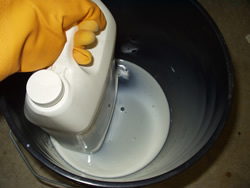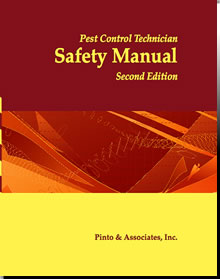Dealing with a Damaged Pesticide Container
A leaking pesticide container demands immediate action. Put on any personal protective equipment, such as rubber gloves or goggles, that is required or suggested on the label. If the leaking is severe, first contain the leak.
 |
| Quickly place a leaking container into a bucket large enough to contain all the pesticide |
| Photo © Pinto & Associates, Inc. |
A quick way to do this is to simply place the container inside a 3-gallon or 5-gallon plastic bucket. If possible, turn the container so that the point of the leak is on top. Then take steps to transfer the pesticide. You have several options:
- Transfer the pesticide into a spray tank and use it as soon as possible at an application site and rate that is listed on the label, or...
- If you have another partially full container of the same product, transfer the pesticide to that container. Be sure that the second container holds exactly the same product at the same concentration and still has its label intact, or...
- Transfer the pesticide to another clean, sturdy container that can be tightly closed. By law, a replacement pesticide container must be properly labeled. If possible, remove the label from the damaged container and securely attach it to the replacement container. Otherwise, mark the replacement container with the product’s name, EPA registration number, signal word, and percent concentration. Then get a copy of the label as soon as possible from your files, the Internet, your pesticide supplier, or from the manufacturer (whose phone number is usually on the label), or...
- Place the entire damaged container with its contents into a suitable larger container, such as a plastic bucket with lid. This should be only a short-term solution for liquid pesticides, however, since the label on a leaking container may become unreadable. The pesticide becomes useless unless you know what it is and can read the label directions. A leaking container of dry pesticide (granules or dust) can be placed inside a heavy duty plastic bag.
- Meanwhile, salvage any puddled concentrate that you can (using a dust pan, sponge, or whatever), and then use kitty litter, sand, or a spill control product to soak up the rest for disposal. Check with the manufacturer to find out how best to decontaminate any leftover residue.
- Remember to triple-rinse the damaged, empty container before disposal.
Note: The contents of a leaky aerosol or other pressurized container can’t be transferred to a replacement container and will have to be carefully disposed of according to label directions.
 |
| If a container appears damaged, use up that pesticide or transfer it to another acceptable container, and properly label it (note unreadable label!) |
| Photo © Pinto & Associates, Inc. |
Of course, it is always best to prevent leaks before they appear. Check the pesticide containers in your shop and in your vehicle regularly.
If you find a pesticide container that is cracked, partially crushed, rusting, or looks corroded, don’t wait until it’s actually leaking. You need to use up that pesticide or transfer it to another acceptable container, and properly label it, as soon as possible.
This article was adapted for the web from material in the Pest Control Technician's Safety Manual.

